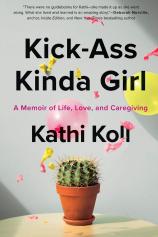Reading Group Guide
Discussion Questions
Kick-Ass Kinda Girl: A Memoir of Life, Love, and Caregiving

1. What do you think motivated Kathi to tell her life story?
2. Chapter 1, titled “The Visual Girl,” references a television show that Kathi was in as a young girl and details Kathi’s life before her marriage to Don Koll. How does “The Visual Girl” describe this stage of her life?
3. How do you think the death of Kathi’s mother when she was such a young woman and the illnesses that plagued her father and brothers have framed Kathi’s character and caregiving nature?
4. The relationship between Mother Dolores and Kathi’s brother Don reveals a devotion that surpasses the traditional view of a love affair. In fact, Mother Dolores says, “Love does not end at the altar.” What does she mean by this?
5. Kathi describes the day that her husband suffered his catastrophic stroke as the dividing line between the two lives she had with him --- going from the peak of the mountain to the bottom of the sea. How did Kathi’s outlook on life change, or did it?
6. One of Don’s doctors counseled Kathi: “Make sure Don doesn’t just live to exist. Make sure he exists to live.” What does this advice mean to you?
7. Don had told Kathi, “There are only three things in life that really matter: food, water, and love. Food and water enable one to exist. Love enables one to live.” Did Kathi and Don’s love and devotion to each other help Don live longer despite the medical realities of his condition? How has your love enabled someone to live more fully?
8. Kathi realized that the best way to give Don strength, happiness, and a will to live would be to allow him to think that, despite the stroke, he was still in charge. She says, “I would be in charge but never let him know that he wasn’t.” How did this approach affect Don’s attitude?
9. Despite Kathi’s outward appearance of strength, inside she was suffering from an emotional roller coaster. If you have ever cared for someone who was sick, did you find yourself holding back true emotions while putting on a brave face? Through therapy Kathi discovered that in her efforts to make life as normal as possible for Don, she had ignored her own needs. Are there situations in your own life when this has happened to you?
10. Kathi describes the “anticipated grief” she experienced not knowing if Don would still be alive when she woke up the next day, or whether he would still be with her at the end of that day. This can be harder to endure than caring for someone with a terminal illness, because the end is unknown. How can one cope with this uncertainty?
11. What role does Mother Dolores play in Kathi’s life? Does she provide more than spiritual solace and companionship?
12. The book begins and ends with Kathi visiting Mother Dolores at the Abbey. How do these visits serve to bookend Kathi’s story and the lives of her two Dons?
13. Were there experiences --- either positive or negative --- that Kathi had or things that she did for Don or for herself that can help you or someone you know who’s in a caregiving role? What were they?
14. The jacket art features a cactus and popped and floating balloons. What do you think the balloons represent? The cactus? Could they be symbolic of one’s resilient nature and strength despite life’s adversity or fragility? What other thoughts do you have about the jacket art?
15. How did you react to the title of Kathi’s memoir? Does it reflect her gutsy nature?
16. Was there anything about Kathi’s life that you wished she had written about in more detail?
17. Do you need to have been or to be a caregiver in order to appreciate Kathi’s story? Or is there inspiration to be found for any reader? Would you recommend this book to a friend?
Kick-Ass Kinda Girl: A Memoir of Life, Love, and Caregiving
- Publication Date: October 9, 2018
- Genres: Health, Inspirational, Memoir, Nonfiction, Women’s Issues
- Paperback: 276 pages
- Publisher: Ward Publishing
- ISBN-10: 1732364907
- ISBN-13: 9781732364905







